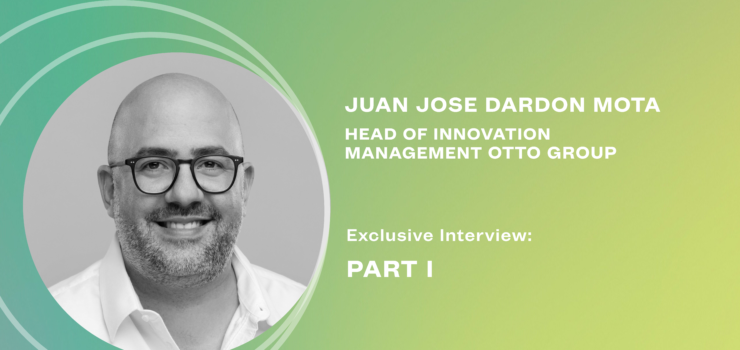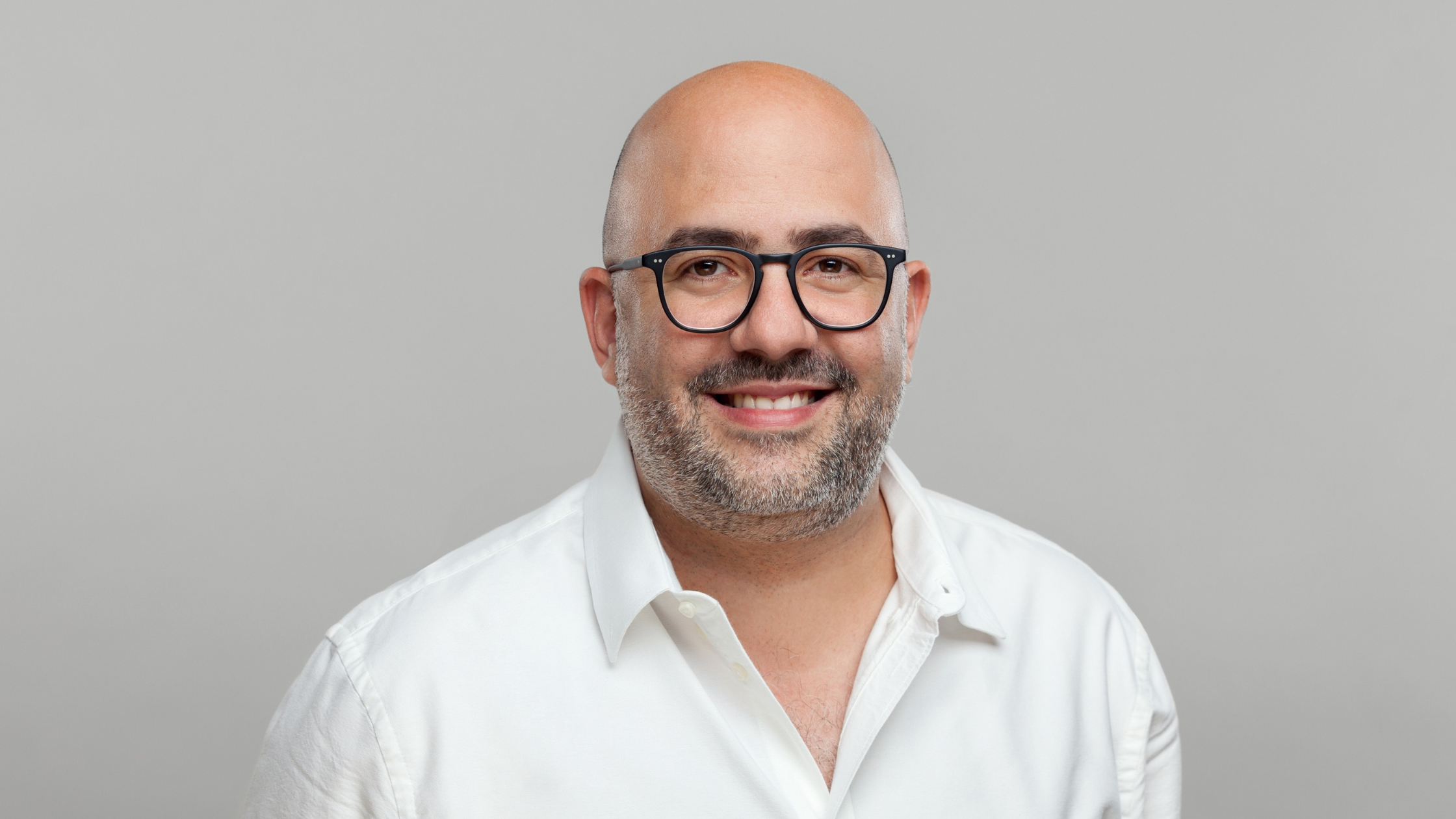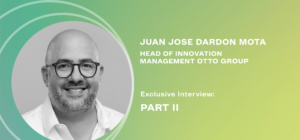Article

Innovation beyond Technology: Interview with Otto Group’s Head of Innovation Management, Juan Jose Dardon Mota (Part I)
Innovation is often considered commonplace for start-ups whereas large companies are known to have challenging times chasing growth via quick adaptation to new trends and disruptive technologies.
However, if we analyze the market, many big-name companies founded decades or a century ago still keep their brands intact. How is that so? May they possibly have a better ability to innovate, or is the right balance of innovation, customer-centric approach and consistent value delivery critical to long-term success?
To get the answers to these questions and to deep dive into the various aspects of corporate innovation, we had the pleasure to talk with the Head of Innovation Management at Otto Group, Juan Jose Dardon Mota.
From a small mail-order company founded in Germany in 1949, the Otto Group, managed to grow into one of the world’s largest e-commerce and service companies, with a clear focus on innovation and digital transformation.
Three years ago, the Otto Group launched “Kulturwandel 4.0” (Cultural Change 4.0) and introduced new working methods, collaboration, and networking in order to advance the possibilities of digitization in a value-adding way.
Read the interview to get insider tips on tackling the various innovation and digital transformation challenges and devise a strategy that brings long-term success.
-
Could you please introduce yourself and let us know how your team helps Otto Group innovate?
Thank you for having me! I’m Head of Innovation at Otto Group. We act as the holding structure of all brands within the group, such as the otto.de, bonprix.de, limango.de, mytoys.de and more. The group’s Innovation Management is part of the Technology Strategy & Governance team that governs all tech-related activities. For example, when the corporation invests in a new warehouse management software, we assist the teams in charge with governance principles like standardization, API set up and various other tech-related aspects.
The innovation management team focuses on supporting all units in the group that do innovation. We undertake the assessments necessary to understand if the projects within a particular brand are worthwhile for the entire group, not just that one brand. We, furthermore, provide ongoing support with implementation and scaling.
Our goal as a group is to look at the jungle of technological innovation from a different perspective and select the technologies that could help us solve problems in the near future. This does not mean that we forget about long-term innovation. Conversely, we give this as an infusion to the group through various workshop formats. We enable innovators inside the group with the knowledge and support necessary for their businesses and customer bases.
The biggest thing that we do is give transparency – we try to understand what everybody is working on and if there are common denominators or joint problems that we, as a group, can support in solving.
-
With a burgeoning number of new trends and technologies emerging in retail, what are the key factors that help you make an optimal selection of new products and technologies that you invest in?
Not every technological trend or advancement is worthwhile adopting. As a group, we have a very diverse setup of companies with different business models. Therefore, not every company must have state-of-the-art technology for the end consumer. Suppose you take the metaverse, for example. In that case, it’s unlikely that most of Otto group’s customers today would move into it quickly, which might not be the case for About You, an online fashion retailer within our group with a younger audience.
The decision is not always easy because the group’s diversity is so immense that when you get decision makers together, it is difficult to come to a joint decision base. However, what helps us, and is at the same time deeply ingrained into our corporation culture, is continuously focusing on the customer. This is easier said than done, as in a corporation of this size, the rise of internal technical and operations issues is quite common and can often distract the focus. But, again, having our customers in the center helps us understand what to do. We also have a clearly defined mission statement inside the group’s innovation management. For every 12 to 15 months, we define focus areas in which we will support innovation initiatives. And these initiatives are marked with specific targets towards the consumers, such as improving the experience, automating the marketing practices, making things available faster, etc. By having that denominator first, we can define benchmarks we can use to make decisions. Every three months, we have a Gremium where we vote for the next significant initiative we will support.
In a nutshell, it is of great importance to understand our problems and our customers’ problems and allocate the budget where it brings the most value.
-
Which projects are currently particularly interesting for OTTO Group?
The one I can share publicly is very straightforward to the business model. At Otto Group, with most of the shops, we sell fashion. I already mentioned the metaverse so let’s address it from the perspective of what problem we solve and what technological features and capabilities we need to be able to arrive there. The fitting issue is one of the most common problems when ordering clothing online. If we start with taking a picture of the piece of t-shirt or pair of shoes on the website, we can create 3D models for each of them. That would follow with virtual try-on, advancements in the size recommendations feature that most of the companies currently offer and eventually enabling the customers to wear real-life clothes in a virtual environment which is to some extent similar to the metaverse.
When I buy an Adidas t-shirt, for example, having the option to compare the size to one of the models I already have and try it on virtually would considerably improve my experience.
In short, we start with the problem that will help improve the user experience, and then we dive deeper into understanding the solution and how much effort it will take to bring it to life.

-
Since the catalogue era, you have been very customer focused. How do you ensure that the end-user is involved in all aspects of the product design and development processes at Otto Group today?
The companies in the group already have a long tradition of involving the customer in a very classical way. Coming from the catalogue world, we have these classical marketing tools: focus groups, tests, and so on. Nevertheless, the catalogue is not there anymore, and businesses are required to move, find solutions and make decisions faster. In that regard, what Otto Group has managed to do in the last six years is to not only look at processes and products that we use to involve the customer but also look at the people working on those products as they are the ones focusing on the customer.
We have a program called Kulturwandel (Cultural change) that drives everyone involved in the value chain to focus on the customer. We also have an internal program called “Love your customer”. So, to work with our people and maintain a mindset of loving our customers is key to being able to still provide the service we do today.

-
What are some of the most significant challenges of having customer-centric product development, and how do you overcome them within the group?
As I already mentioned, one of the main challenges is that sometimes the daily business might be related to what the customer is experiencing on one of the websites. However, our people are oftentimes exposed to operational challenges such as failure of the warehouse management systems, unavailability to access connectors, translation of data, and more. Solving these issues incurs high costs, and the impact on the end consumer is low, at least in the beginning.
In the context of involving the customer in the product development process, digitalization of production is one of the fields that we are constantly working on improving. If we take the design of a t-shirt as an example, having everything in a digital format and not needing to provide the focus group with a physical product makes a huge impact.
-
The emergence of digital-first online retailers has created new challenges for German retailers known for their high quality and loyalty to principles. In your view, what are the main challenges imposed by the latest market conditions and what does it take for the German retail sector to keep up with the global competition?
The problem does not necessarily lie in the fact that the competition is digital-first. Looking from a technical perspective, the biggest challenge is that companies such as Otto Group have built a whole landscape of enterprise architecture within the past decades, and the bigger we get, the more challenging it becomes to deal with the emergence of new technologies that allow you to move entirely to cloud or to be reliant on software release processes that don’t require building pipelines. This is what hinders established corporations with a long history of existence from innovating as fast as others do. However, sticking to high-quality standards and living the company values help keep your brand intact, although you are slower and can not grab low-hanging fruits as fast as others. On the positive side, customers are conscious about what and where they purchase; this trend gets even more deeply ingrained into the younger generations. Once they become your focus target, this strategy will pay off. So, if you can leverage the business aspects where you can innovate fast, quickly act on the market changes, and keep the balance between quality, innovation, and values, you are a winner.
People at Otto Group have a way closer identity with the brand, which stems from having the essence deeply ingrained in our DNA.

On the other hand, I have a long experience working with startups. So, suppose we take the startups and/or the digital-first companies. In that case, we can not neglect that they can offer various advantages such as better transparency and prices – which is excellent as their existence strengthens the competition. However, building something great in a short period is not always accomplishable and often results in big layoffs because it was not built on solid ground.
In conclusion, it is just a matter of time. Once you reach that tipping point where you can react as fast as the competitors, you will see your actual size and power.

-
You specialize in advising companies with product concepts & specifications, tool selection & implementation, team setup and agile processes. What is your advice for entrepreneurs and leadership teams looking to build successful products?
I might be biased with the answer because I am a product person, and my solution is always product first. However, it is a continuous learning process.
I will start by sharing my first startup experience from 20 years ago to connect the dots better. At my first job, we didn’t know what we were doing. We had the fabulous idea of building a page that displays a specific type of information for customers. We never talked to a customer or tried to understand what exactly would be the best practice. If we had known more about product management back then, we would have been more efficient. On that note, what is good to see nowadays is that product management has become deeply ingrained into the startup scene and product building in general, and customer focus drives the product mindset. However, often, when I speak to founders, they would still argue that their website looks great. Although, the question is not whether they like it or not but whether the customer likes it.
So, my advice to founders is to start with understanding the product vision and instilling the product mindset deeply in the company’s DNA. One of the mistakes that many startups that achieve hypergrowth for a short time make is turning themselves into a company that works in silos, similar to what big corporations they initially criticized do. That should not happen. As a startup founder, you should always make sure that your salesperson, for example, understands the product vision and does not just focus on the number of leads they bring in and the deals they win. I had a case where the sales team sent the client’s requirements to the IT team and had to wait for one month to get feedback. You can easily avoid such a scenario if everyone has a product mindset from the very beginning.
A great book I recommend is ‘Four steps to Epiphany’ by Steve blank. One specific graphic in the book illustrates the steps of product development that help products reach market fit. If you build that product mindset as an entrepreneur and root that deeply into your culture, you can build successful products that solve your customers’ problems.

You may have noticed that a critical link in the pursuit of innovation and business scaling is missing in this interview – sustainability. At Otto Group, social and environmental sustainability aspects have been integral to everything they do from day one. To highlight the importance of this topic, we will publish a separate interview that addresses one of the most pressing issues nowadays and showcases how Otto Group has managed to build a culture that provides values at all business and societal levels.
Stay tuned – the second part of the interview is coming soon!

About Juan Jose Dardon Mota
Juan Jose Dardon Mota (42, JJ for short) is Head of Innovation Management in the Otto Group. Born in Guatemala, he has almost 20 years of experience in product management. After beginnings at guenstiger.de, JJ landed in the Berlin start-up world. He spent ten years building and managing product teams for various startups from Axel Springer, Rocket Internet and Finleap.
JJ now lives in Hamburg-Volksdorf with his wife and two young sons, loves FC Barcelona and Metallica, and enjoys spending his vacations in Andalusia, his mother’s homeland.
About Author
Elena Dimoska is a communications & marketing enthusiast with great passion to communicate value in a way that reinforces business success beyond revenue growth.
One of her missions as part of TrueNode is to internalize the topic of innovation and digital transformation in large enterprises and to help more well-known brands leverage innovation to make impact. For that purpose, Elena is interviewing innovators from well-established brands across Germany and Europe.






